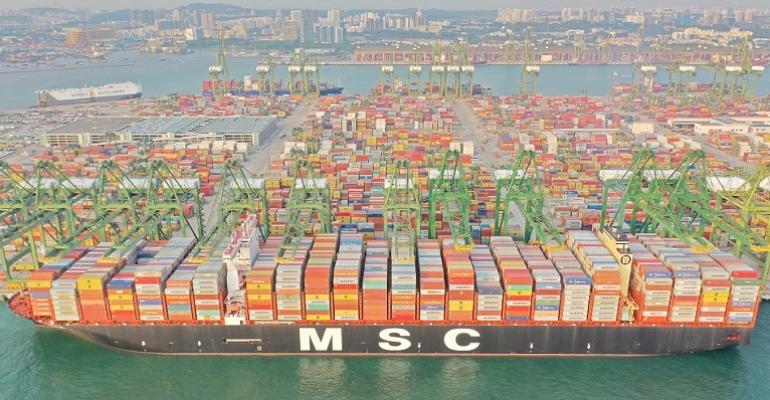Alphaliner’s latest weekly report on the shipping market says that the idled fleet is now at its lowest level for more than 22 months at just 84 ships of which one is larger than 12,500 teu and none are greater than 18,000 teu.
The number of vessels that are in repair yards has also dropped significantly over the last two weeks, falling to 99 ships on 12 February, totalling 236,266 teu, an average size of under 2,400 teu. A reduction of six ships, consisting of 73,769 teu, averaging around 12,300 teu per vessel.
According to the Alphaliner report, in comparison to last year this is a substantial reduction, with “the combined idle and ‘ships in yard’ capacity collectively represented 6.2% of the container fleet a year ago, versus 1.5% today.”
Stefan Verberckmoes, analyst at Alphaliner, told Seatrade Maritime News: “You can certainly say that the Red Sea crisis has changed the dynamics for the industry. A lot of extra tonnage is needed and all newbuildings - and there are a lot of them currently - are immediately introduced in East West loops.”
Currently any new tonnage delivered is heading straight into the Asia to Europe trades to help carriers maintain services on the European trades out of Asia, which Alphaliner says requires at least two and in some cases three ships to maintain a weekly service trading around the Cape of Good Hope.
As the first vessels to be diverted from Suez are now arriving back in Asia Alphaliner points to “a ‘lucky’ coincidence that the return of the first batch of diverted ships falls in the traditionally ‘slow’ period after Chinese New Year, when shipping lines tend to blank a number of sailings.”
According to the analyst the Ocean Alliance has struggled to find sufficient tonnage to cover its services, particularly into the Mediterranean. However, 2M has managed to keep blanked sailings to a minimum.
In an effort to maintain services some carriers have offered ad hoc sailings using smaller tonnage to fill a gap in the scheduling. Maersk, CMA CGM, Hapag-Lloyd, HMM, Evergreen and Cosco have all deployed ships of between 1,800 and 6,000 teu and one 11,000 and one 20,000 teu ship, have all deployed vessels for this purpose.
2M has been the most successful alliance in maintaining its services with a slew of newbuildings being deployed into the alliance’s Asia to Europe services.
“Despite increasing the round voyage time of the ‘Dragon’ to seventeen weeks, MSC did not have to drop a single sailing in January and February, as it could deploy the large neo-panamax newbuildings MSC Azra, MSC Rose and MSC Anita fresh from the yard,” reported the broker.
![2024 deliveries (TEU) Credit S&P Global[8].jpg 2024 deliveries (TEU) Credit S&P Global[8].jpg](/sites/cet.com/files/2024%20deliveries%20%28TEU%29%20Credit%20S%26P%20Global%5B8%5D.jpg)
2024 containership deliveries in TEU capacity - S&P Global
In addition, THE Alliance was able to rapidly respond to the Red Sea crisis, given that it had already suspended its south Asia to Europe and Asia to USEC services in November, releasing 22 ships for the remaining diverted services, including those to the Mediterranean.
On average the 2M alliance managed 7.4 weekly sailings to north Europe and 7.3 to the Med, THEA averaged 7.0 to north Europe and 7.4 to the Med, while the Ocean Alliance, which had few newbuildings and no cancelled services to free tonnage, averaged 6.3 and 5.0 respectively, in the seven weeks of this year.
Chartering tonnage has also been a challenge as the charterers had few vessels to choose from, and Alphaliner reports that Danaos, a major non-operating owner (NOO), “Had secured additional charters for vessels at ‘very healthy levels’ due to the Red Sea situation as extra ton miles creates additional vessel demand. The NOO now has contract coverage for its fleet of 95.8% for 2024 and 62.0% for 2025.”
Danaos reported similar income for 2023, at $567.6 million compared to $563.8 million in 2022.
Although tonnage is currently tight, in what is the early stages of the diversion of tonnage around the Cape, Alphaliner acknowledges that with much more capacity to come the current situation remains fluid.
“There is, however, more capacity under construction for delivery in 2024 and 2025 than is needed for Cape diversions,” said Verberckmoes. “We still feel that the market is heading for an overcapacity scenario, but the Red Sea crisis is just delaying this. As soon as the Suez routing is safe again, a lot of ships will become redundant.”
He added: “We also see that vessel scrapping, which was expected to significantly increase, has stayed at a low level as long as the Red Sea crisis looms.”
Copyright © 2024. All rights reserved. Seatrade, a trading name of Informa Markets (UK) Limited.
Add Seatrade Maritime News to your Google News feed.  |

